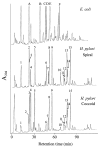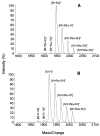The morphological transition of Helicobacter pylori cells from spiral to coccoid is preceded by a substantial modification of the cell wall
- PMID: 10368145
- PMCID: PMC93848
- DOI: 10.1128/JB.181.12.3710-3715.1999
The morphological transition of Helicobacter pylori cells from spiral to coccoid is preceded by a substantial modification of the cell wall
Abstract
The peptidoglycan (murein) of Helicobacter pylori has been investigated by high-performance liquid chromatography and mass spectrometric techniques. Murein from H. pylori corresponded to the A1gamma chemotype, but the muropeptide elution patterns were substantially different from the one for Escherichia coli in that the former produced high proportions of muropeptides with a pentapeptide side chain (about 60 mol%), with Gly residues as the C-terminal amino acid (5 to 10 mol%), and with (1-->6)anhydro-N-acetylmuramic acid (13 to 18 mol%). H. pylori murein also lacks murein-bound lipoprotein, trimeric muropeptides, and (L-D) cross-linked muropeptides. Cessation of growth and transition to coccoid shape triggered an increase in N-acetylglucosaminyl-N-acetylmuramyl-L-Ala-D-Glu (approximately 20 mol%), apparently at the expense of monomeric muropeptides with tri- and tetrapeptide side chains. Muropeptides with (1-->6)anhydro-muramic acid and with Gly were also more abundant in resting cells.
Figures



Similar articles
-
Structure of peptidoglycan from Thermus thermophilus HB8.J Bacteriol. 1995 Sep;177(17):4947-62. doi: 10.1128/jb.177.17.4947-4962.1995. J Bacteriol. 1995. PMID: 7665471 Free PMC article.
-
Cell wall structural divergence among Thermus spp.FEMS Microbiol Lett. 1999 Mar 15;172(2):223-9. doi: 10.1111/j.1574-6968.1999.tb13472.x. FEMS Microbiol Lett. 1999. PMID: 19606554
-
Molecular weight-determination of biosynthetically modified monomeric and oligomeric muropeptides from Escherichia coli by plasma desorption-mass spectrometry.FEBS Lett. 1993 Jan 25;316(2):181-5. doi: 10.1016/0014-5793(93)81211-h. FEBS Lett. 1993. PMID: 8420803
-
Murein (peptidoglycan) structure, architecture and biosynthesis in Escherichia coli.Biochim Biophys Acta. 2008 Sep;1778(9):1714-34. doi: 10.1016/j.bbamem.2007.06.007. Epub 2007 Jun 16. Biochim Biophys Acta. 2008. PMID: 17658458 Review.
-
Helicobacter pylori-coccoid forms and biofilm formation.FEMS Immunol Med Microbiol. 2009 Jul;56(2):112-5. doi: 10.1111/j.1574-695X.2009.00556.x. Epub 2009 Apr 27. FEMS Immunol Med Microbiol. 2009. PMID: 19453756 Review.
Cited by
-
The hidden base of the iceberg: gut peptidoglycome dynamics is foundational to its influence on the host.Gut Microbes. 2024 Jan-Dec;16(1):2395099. doi: 10.1080/19490976.2024.2395099. Epub 2024 Sep 6. Gut Microbes. 2024. PMID: 39239828 Free PMC article. Review.
-
Growth medium-dependent glycine incorporation into the peptidoglycan of Caulobacter crescentus.PLoS One. 2013;8(2):e57579. doi: 10.1371/journal.pone.0057579. Epub 2013 Feb 28. PLoS One. 2013. PMID: 23469030 Free PMC article.
-
Phenotypic Variations of Oleispira antarctica RB-8(T) in Different Growth Conditions.Curr Microbiol. 2020 Nov;77(11):3414-3421. doi: 10.1007/s00284-020-02143-8. Epub 2020 Aug 1. Curr Microbiol. 2020. PMID: 32740715
-
Virulence and potential pathogenicity of coccoid Helicobacter pylori induced by antibiotics.World J Gastroenterol. 2001 Apr;7(2):254-8. doi: 10.3748/wjg.v7.i2.254. World J Gastroenterol. 2001. PMID: 11819770 Free PMC article.
-
Putative mechanisms and biological role of coccoid form formation in Campylobacter jejuni.Eur J Microbiol Immunol (Bp). 2012 Mar;2(1):41-9. doi: 10.1556/EuJMI.2.2012.1.7. Epub 2012 Mar 17. Eur J Microbiol Immunol (Bp). 2012. PMID: 24611120 Free PMC article. Review.
References
-
- Aleljung P, Nilsson H O, Wang X, Nyberg P, Morner T, Warsame I, Wadstrom T. Gastrointestinal colonisation of BALB/cA mice by Helicobacter pylorimonitored by heparin magnetic separation. FEMS Immunol Med Microbiol. 1996;13:303–309. - PubMed
-
- Blaser M J. Helicobacter pyloriand the pathogenesis of gastroduodenal inflammation. J Infect Dis. 1990;161:626–633. - PubMed
-
- Braun V, Wu H C. Lipoproteins, structure, function, biosynthesis and model for protein export. In: Ghuysen J M, Hakenbeck R, editors. Bacterial cell wall. Amsterdam, The Netherlands: Elsevier Science Publisher; 1994. pp. 319–341.
Publication types
MeSH terms
Substances
LinkOut - more resources
Full Text Sources
Research Materials

